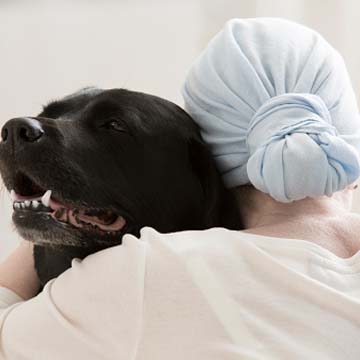In-Home Hospice Care
A specialized form of veterinary treatment given to terminally sick or elderly pets in the comfort of their own homes is known as pet in-home hospice care.
Palliative Care and Pain Management Services
Palliative care is a tool to provide comfort and pain management to pets that have a chronic or terminal illness in order to improve their quality of life. The pet demonstrates certain care needs and may or may not have a life-limiting condition. The focus is not on a cure but to ensure the pet is comfortable and retains their dignity. There is nothing more rewarding than hearing an owner say that their pet is a whole new dog or cat after their pain has been alleviated. Many people attribute a senior pet slowing down to the aging process, but this usually indicates that the pet is in pain. How wonderful it is that we can help these pets FEEL better, improve their quality of life and allow owners to confidently engage in their comfort care!
Common conditions managed with palliation:
- Chronic Osteoarthritis/Mobility Issues
- Chronic kidney disease
- Diabetes mellitus
- Cancer
- Cushing’s Syndrome
- Heart Disease
Services Include (but are not limited to):
- Detailed Consultation
- Mobility and Hygiene Recommendations
- Complete Physical Exam
- Environmental Evaluation and Guidance
- Pain Assessment, Treatment
- Review of Home Care Routines
- Nutritional Counseling
Why Choose Hospice Care?
Before making the decision to enter your pet into a palliative or hospice care program, it is important to consult with your primary care veterinarian and carefully consider all treatment options available for your pet’s diagnosed medical condition(s).
Many families choose hospice care after their pets have received a terminal illness diagnosis, when their senior pets are at the end of life, or to buy some time so that a spouse, child, or family member has a chance to say goodbye. Whether it is weeks, days, or hours that your pet has left, you need to know what to expect and how to prepare for issues that may arise. Pet hospice focuses on the family-pet-veterinary team relationship. Our veterinary team is there to assist your family in making the best decisions for you and your pet. Most importantly, we educate you about your pet’s diagnosis and prognosis, as well as use our medical knowledge to assist you in making important decisions regarding disease management based on your pet’s individual needs while respecting your family’s wishes on this journey. Our caring team will be there by your side every step of the way. If you have the resources available to support hospice care, availability and desire to care for your pet during their last days or weeks, and a support team in place, then reach out to us today. “A caring hand is just a phone call away.” – Dr. Jessica Hudspeth.


Description of Appointments:
Palliative/Pain Medicine and Hospice Care Consultations are 2 hours in duration and include the comprehensive initial exam, extended consultation, review of medical records, treatment plan individualized for your pet, and 30 days of medical management (virtual/email). Your pet’s plan will change and evolve over time and will need to be modified as your pet’s condition changes. You must provide copies of your pet’s medical records at least 24 hours prior to the scheduled appointment to allow our team ample time to review their medical history. Failure to do so may result in rescheduling. If you wish to schedule a hospice care appointment, call us at (832) 856-1617 or email info@caringhandspethospice.com. Please note that all appointments require a $100 deposit to hold the appointment. Additionally, we do not provide services to aggressive pets due to our doctor’s physical limitations.
Is It Time?
The hardest question of all is when to euthanize a pet.
There is never a time that it becomes an easy decision to say goodbye to a beloved friend, even when we have exhausted all our medical resources and we know that a disease may be terminal. What is most important for pet owners to understand is the quality of life of their pets, and this may not always be the easiest thing to recognize and evaluate. Even in the event of a medical crisis, when we know that our four-legged friend is suffering, making the decision to let go remains a difficult and often painful decision.
When you recognize that supportive medical and emotional care for your pet can no longer be provided, we will support the choice to euthanize- we are here to help during this difficult time. After all, providing our loved ones with dignity and peace when they are struggling is the best gift we can give them when they have given us so much. Ultimately the quality of life of your pet is paramount in any decision that should be made- the following gives a description of aspects of quality of life to consider.
Defining “Quality of Life” – by Moira Anderson Allen, M.Ed.
Whenever one considers the painful choice of euthanasia, it is always advised to take your pet’s “quality of life” into account. How can you determine whether a pet is still experiencing a good quality of life — or whether its level of suffering is no longer acceptable?
That decision is individual to every pet and every owner. Following, however, are some factors to consider when attempting to assess your pet’s quality of life:
Mobility:
An older pet often loses mobility. A dog may no longer be able to climb stairs or hop into a car; a cat may lose the ability to jump onto a bed or chair. At this stage, however, your pet may still be healthy and happy, and you can easily make accommodations for their reduced ability.
If, however, your pet can barely move, that’s another matter. Can your pet get to their feet without assistance? Can they sit or lie down without collapsing? Can they walk? Can they handle basic functions, such as squatting on a litter box? Do they whimper or growl if you attempt to move them? I’ve seen dogs so crippled with hip dysplasia that they literally had to drag their immobilized hindquarters across the floor; this hardly represents the “quality of life” I want for my pets.
Appetite/Eating Ability:
Is your pet able to eat? Can they consume enough food (or digest that food) to remain properly nourished? Do they regurgitate immediately after eating? Are they unable to chew, or do they have difficulty swallowing? Do they enjoy eating, or do you have to coax every bite past their lips? A pet that is unable to eat or gain sufficient nourishment from their food is on a slow road to starvation.
Breathing:
Several illnesses, including cancer, can affect the lungs. When a condition causes the lungs to fill with fluid or foreign matter (such as cancer cells), a pet quickly loses their ability to breathe easily or comfortably. You’ll notice that your pet may seem to be panting or that they are laboring to breathe; often, you’ll see their stomach or flanks “pumping” as they can no longer breathe with just the chest muscles. They may also experience wheezing attacks. If such symptoms occur, ask for a chest x-ray to determine the condition of the lungs. If the problem is due to an allergy, infection, or asthma, medication may help; if it is due to fluids that are the result of cancer or a heart condition, however, little can be done.
Discomfort:
It can be difficult to determine whether a pet is in pain, as animals instinctively mask discomfort as much as possible. You can pick up clues, however, by watching their posture and expression. Does your pet’s face appear furrowed or “worried” rather than relaxed and happy? Do they sit hunched or “hunkered” and tense rather than relaxing and lying down? Lack of mobility can also be a sign of pain.
Another indication of pain is “denning.” An animal in pain will seek a safe place where it won’t be disturbed by other animals. If your pet has forsaken their usual territories or sleeping places for the back of the closet or a spot under the bed, this may be a sign that they are in pain or distress and feel vulnerable.
A more obvious indication of pain is a pet’s reaction to touch. If your pet responds to touch by flinching away, hissing, snarling, or even snapping, this is a clear indication of pain. Sometimes this can indicate localized pain; if the pet doesn’t want to be touched at all, however, it may indicate a broader discomfort.
Incontinence:
Incontinence is the inability to control one’s bladder or bowels and is common in senior pets. Many pet owners feel terribly guilty over the natural annoyance they feel when a pet becomes incontinent. They feel they should be more loving, more patient. Incontinence, however, can also be stressful for the pet. As a basic survival mechanism, animals learn not to “mess where they sleep” (for the smell would draw attention to the location of one’s den). When an animal can no longer control when or where they urinate or defecate, you can be sure they are not happy with the situation.
Mental Capacity:
Older pets occasionally develop signs of diminished mental capacity. They may seem to “forget” things, such as where a toy is located or what a command means. Such a pet may become confused by its surroundings, and this confusion can develop into fear. (In some cases, this “confusion” may be the result of hearing or vision loss, to which both you and your pet can often adapt.)
Happiness:
Determining whether your pet is “enjoying” life is certainly a subjective decision. However, if you have been a keen observer of your pet’s behavior and attitude during their lifetime, you are likely to be able to determine when they no longer seem “happy.” You’ll know when they no longer seem to take any pleasure from their food, toys, surroundings — and most of all, from contact with you and the rest of their family. Most pets are tremendously easy to please; when it no longer becomes possible to raise a purr or a tail-wag, you can be certain that your pet is receiving little joy from life.
Response To Treatment:
When a pet becomes ill, our natural response is to provide whatever treatment we can. This may mean tests, medications, or even surgery. But drugs have side effects, repeated trips to the vet cause emotional distress, and more invasive treatments take a physical toll. Eventually, we may conclude that our efforts to treat a pet’s illness are more stressful to the pet than the condition itself — and that our efforts to save a pet’s life are diminishing, rather than enhancing, the quality of that life.


